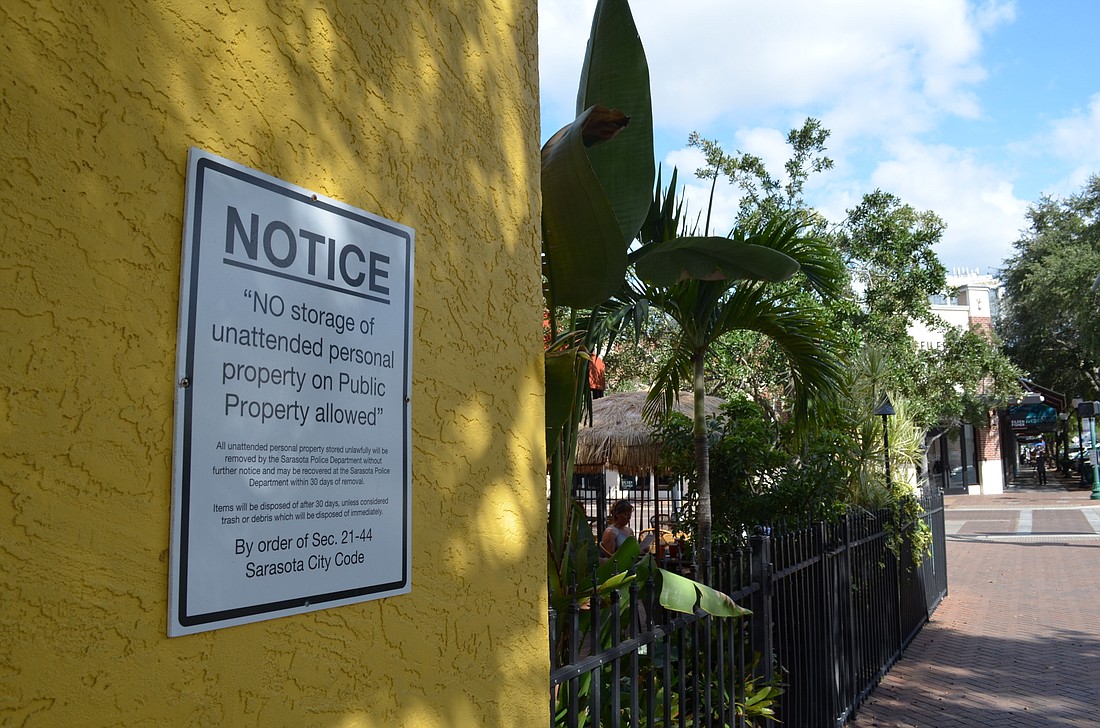- April 25, 2025
-
-
Loading

Loading

The Sarasota City Commission passed an ordinance on Monday that bans sitting and reclining on the sidewalk in what was called a Pedestrian Activity Zone, along Main Street and along Palm Avenue, with a plan to evaluate the ordinance’s boundaries.
Labeled a no sit/lie ordinance, the restriction has been used in areas with high pedestrian traffic during allotted times in other Florida cities, including Clearwater, St. Petersburg and Orlando. As of now, the rule will be in effect from 10 a.m. to midnight in Sarasota.
“It would prohibit sitting and laying between the edge of the roadway and the parallel property line. In other words, on public sidewalks during designated hours of the day,” Sarasota City Attorney Robert Fournier said. “The conventional ordinance just addresses obstruction to the sidewalk. We’re talking now about a second type of ordinance developed more recently.”
The potential for a new sidewalk rule was first discussed in June of last year.
Fournier said the new ordinance was formed, and has been adopted by other cities, to curb large groups of people from gathering on the sidewalk for an extended period of time. The justification for the ordinance is to maintain public safety on sidewalks and to preserve economic viability of the businesses near them, according to Fournier.
Ordinance exemptions include medical emergencies, special events and sidewalk seating provided by businesses. Fournier acknowledged the concern that the ordinance cannot legally target specific groups, such as homeless people, and said he anticipated possible pushback on the ordinance.
“It is not a valid purpose to rid the downtown, or a certain part of downtown, of a certain segment of the population. You know, usually homeless people who may be out on the streets,” Fournier said. “Some people may think that that should be, but that’s not a valid municipal purpose to adopt this ordinance.”
The motion to approve the ordinance also came with an agreement that the ordinance’s boundaries would be evaluated. Yet, Fournier said that people who sit or lay on the sidewalk outside of the ordinance’s hours or boundaries can still be cited due to an existing ordinance in place.
However, Fournier said no citations had been given for obstructing the sidewalk under the existing ordinance. He said the lack of citations were not due to a lack of a problem but because officers were required to give violators a warning before issuing a citation.
“I think we speculated the lack of citations was because of the policy to educate before enforcement,” Fournier said. “Now I think there were no citations under the ordinance because there’s a provision that required an officer to inform somebody they are in violation of the ordinance. What happened is that everybody complies.”
Signs will be posted where the new ordinance is in place.
Not only was the ordinance unanimously approved by City Commissioners, but it also had the support of two public speakers including Sarasota resident John Bordeaux, who asked for the ordinance to be expanded to include all hours of the day.
“This is not intended to ban the homeless from downtown, as some would suggest,” Bordeaux said. “But rather ban individuals who sit, lie and sleep on city sidewalks.”
“I want this ordinance to be active 24 hours a day, seven days per week,” Bordeaux continued. “It needs to be expanded to essentially the entirety of downtown.”
Commissioner Jen Ahearn-Koch, who later voted to approve the ordinance, initially pushed back on the idea. She questioned why an additional ordinance was needed.
Deputy City Manager Pat Robinson addressed Ahearn-Koch’s questions. He acknowledged a risk of future legal problems but supported the ordinance as an “additional tool for officers.”
“A number of these cities that we looked at, when they expanded this it became problematic and were shot down on Constitutional grounds,” Robinson said. “But in a limited scope, I think that it’s a prudent course of action at this point.”
Ahearn-Koch then asked Robinson if the ordinance would be a tool or a liability for the city. Robinson concluded there was no data to show the ordinance’s effectiveness and that they would just have to see, moments before the unanimous vote to approve the ordinance.
Commissioner Hagen Brody said the ordinance was important for Sarasota’s effort to keep its charm. He said the ordinance could alleviate parking and crowd concerns and create a safer environment.
According to Fournier, if a person receives a second warning for sitting or laying on the street, they are not promised a warning and could receive a notice to appear in court, which leaves open the possibility for arrest.